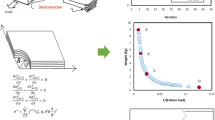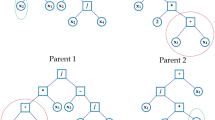Abstract
Multifunctional application of laminated composites requires multi-objective optimization of their characteristics. In this paper, the ply angles of laminated composites are determined in order to maximize the effective in-plane elastic constants simultaneously. These constants are determined by considering a representative small element of the laminated composite and imposing the conditions of uniformity of out-of-plane stresses and in-plane strains at orthotropic layer interfaces. Then, by combining the artificial bee colony algorithm and various multi-objective optimization methods, the optimal ply angles and the corresponding co-optimized constants are determined. The correctness and accuracy of the method is verified not only by providing a comparison with the existing results but also by solving a known problem. The results are presented and discussed, considering different multi-objective optimization problems. The results show that the increasing number of layers in the problem of simultaneous optimization of Young’s moduli not only does result in finding more Pareto optimal solutions in the feasible objective region but also shifts the Pareto frontier toward the utopia point. However, when the shear modulus optimization is engaged in the problem, using more than two layers only leads to obtaining more Pareto optimal answers.

Graphical abstract






Similar content being viewed by others
Data availability
All data required to reproduce these findings exists in the text. It should be noted that the replication of these findings with enough number of cycles would result in the same objective values and similar variable values. However, the order of variables may change. A sample set of Matlab codes for determining the Pareto frontier in the problem of simultaneous optimization of Ex and Ey is available to download from [https://doi.org/10.17632/pkgty346y7.1].
References
Kaveh A, Dadras A, Malek NG (2018) Buckling load of laminated composite plates using three variants of the biogeography-based optimization algorithm. Acta Mech 229(4):1551–1566. https://doi.org/10.1007/s00707-017-2068-0
Nikbakt S, Kamarian S, Shakeri M (2018) A review on optimization of composite structures part I: laminated composites. Compos Struct 195:158–185. https://doi.org/10.1016/j.compstruct.2018.03.063
Wang X, Liu X, Yuan H et al (2018) Non-covalently functionalized graphene strengthened poly(vinyl alcohol). Mater Des 139:372–379. https://doi.org/10.1016/j.matdes.2017.11.023
Wang X, Pan Y, Qin Y et al (2018) Creep and recovery behavior of injection-molded isotactic polypropylene with controllable skin-core structure. Polym Test 69:478–484. https://doi.org/10.1016/j.polymertesting.2018.05.040
Chen CM, Kam TY (2007) Elastic constants identification of symmetric angle-ply laminates via a two-level optimization approach. Compos Sci Technol 67(3–4):698–706. https://doi.org/10.1016/j.compscitech.2006.04.016
Kovalovs A, Rucevskis S (2011) Identification of elastic properties of composite plate. IOP Conf Ser Mater Sci Eng 23(1):012034. https://doi.org/10.1088/1757-899X/23/1/012034
Valencia CAM, Pazos-Ospina JF, Franco EE et al (2015) Ultrasonic determination of the elastic constants of epoxy-natural fiber composites. Phys Procedia 70:467–470. https://doi.org/10.1016/j.phpro.2015.08.287
Chou PC, Carleone J, Hsu CM (1972) Elastic constants of layered media. J Compos Mater 6(1):80–93. https://doi.org/10.1177/002199837200600107
Bogetti TA, Hoppel CPR, Harik VM et al (2004) Predicting the nonlinear response and progressive failure of composite laminates. Compos Sci Technol 64(3–4):329–342. https://doi.org/10.1016/B978-008044475-8/50017-2
Bogetti TA, Staniszewski J, Burns BP et al (2012) Predicting the nonlinear response and progressive failure of composite laminates under tri-axial loading. J Compos Mater 46(19–20):2443–2459. https://doi.org/10.1177/0021998312449889
Lv G, Zhang N, Huang M et al (2018) The remarkably enhanced particle erosion resistance and toughness properties of glass fiber/epoxy composites via thermoplastic polyurethane nonwoven fabric. Polym Test 69:470–477. https://doi.org/10.1016/j.polymertesting.2018.06.005
Xu Y, Zhu J, Wu Z et al (2018) A review on the design of laminated composite structures: constant and variable stiffness design and topology optimization. Adv Compos Hybrid Mater 1(3):460–477. https://doi.org/10.1007/s42114-018-0032-7
Dong C, Davies IJ (2018) Effect of stacking sequence on the flexural properties of carbon and glass fibre-reinforced hybrid composites. Adv Compos Hybrid Mater 1(3):530–540. https://doi.org/10.1007/s42114-018-0034-5
Gürdal Z, Haftka RT, Hajela P (1999) Design and optimization of laminated composite materials. Wiley, Hoboken
An H, Chen S, Huang H (2018) Stacking sequence optimization and blending design of laminated composite structures. Struct Multidiscip Optim. https://doi.org/10.1007/s00158-018-2158-1
Chang N, Wang W, Yang W, Wang J (2010) Ply stacking sequence optimization of composite laminate by permutation discrete particle swarm optimization. Struct Multidiscip Optim 41(2):179–187. https://doi.org/10.1007/s00158-009-0417-x
Muc A, Gurba W (2001) Genetic algorithms and finite element analysis in optimization of composite structures. Compos Struct 54(2–3):275–281. https://doi.org/10.1016/S0263-8223(01)00098-8
Liu X, Li C, Pan Y et al (2019) Shear-induced rheological and electrical properties of molten poly(methyl methacrylate)/carbon black nanocomposites. Compos Part B 164:37–44. https://doi.org/10.1016/j.compositesb.2018.11.054
Chen Y, Fu K, Hou S et al (2018) Multi-objective optimization for designing a composite sandwich structure under normal and 45° impact loadings. Compos Part B 142:159–170. https://doi.org/10.1016/j.compositesb.2018.01.020
An H, Chen S, Huang H (2018) Multi-objective optimization of a composite stiffened panel for hybrid design of stiffener layout and laminate stacking sequence. Struct Multidiscip Optim 57(4):1411–1426. https://doi.org/10.1007/s00158-018-1918-2
Fagan EM, De La Torre O, Leen SB, Goggins J (2018) Validation of the multi-objective structural optimisation of a composite wind turbine blade. Compos Struct 204:567–577. https://doi.org/10.1016/j.compstruct.2018.07.114
Chen S, Zhu W, Cheng Y (2018) Multi-objective optimization of acoustic performances of polyurethane foam composites. Polymers 10(7):788. https://doi.org/10.3390/polym10070788
Wang C, Wang W, Zhao W et al (2018) Structure design and multi-objective optimization of a novel NPR bumper system. Compos Part B 153:78–96. https://doi.org/10.1016/j.compositesb.2018.07.024
Park CH, Lee W II, Han WS, Vautrin A (2004) Simultaneous optimization of composite structures considering mechanical performance and manufacturing cost. Compos Struct 65(1):117–127. https://doi.org/10.1016/j.compstruct.2003.10.010
Omkar SN, Khandelwal R, Yathindra S et al (2008) Artificial immune system for multi-objective design optimization of composite structures. Eng Appl Artif Intell 21(8):1416–1429. https://doi.org/10.1016/j.engappai.2008.01.002
Bloomfield MW, Diaconu CG, Weaver PM (2009) On feasible regions of lamination parameters for lay-up optimization of laminated composites. Proc R Soc A 465(2104):1123–1143. https://doi.org/10.1098/rspa.2008.0380
Ghiasi H, Pasini D, Lessard L (2009) Optimum stacking sequence design of composite materials part I: constant stiffness design. Compos Struct 90(1):1–11. https://doi.org/10.1016/j.compstruct.2009.01.006
Ghiasi H, Fayazbakhsh K, Pasini D, Lessard L (2010) Optimum stacking sequence design of composite materials part II: variable stiffness design. Compos Struct 93(1):1–13. https://doi.org/10.1016/j.compstruct.2010.06.001
Zuo ZH, Xie YM (2014) Maximizing the effective stiffness of laminate composite materials. Comput Mater Sci 83:57–63. https://doi.org/10.1016/j.commatsci.2013.11.010
Karaboga D, Basturk B (2007) A powerful and efficient algorithm for numerical function optimization: artificial bee colony (ABC) algorithm. J Glob Optim 39(3):459–471. https://doi.org/10.1007/s10898-007-9149-x
Karaboga D, Akay B (2009) A comparative study of artificial bee colony algorithm. Appl Math Comput 214(1):108–132. https://doi.org/10.1016/j.amc.2009.03.090
Karaboga D, Gorkemli B, Ozturk C, Karaboga N (2014) A comprehensive survey: artificial bee colony (ABC) algorithm and applications. Artif Intell Rev 42(1):21–57. https://doi.org/10.1007/s10462-012-9328-0
Karaboga D, Basturk B (2008) On the performance of artificial bee colony (ABC) algorithm. Appl Soft Comput 8(1):687–697. https://doi.org/10.1016/j.asoc.2007.05.007
Arora JS (2012) Multi-objective optimum design concepts and methods. In: Introduction to optimum design. Elsevier, Amsterdam, pp 657–679
Messac A, Sundararaj GJ, Tappeta RV, Renaud JE (2000) Ability of objective functions to generate points on nonconvex Pareto Frontiers. AIAA J 38(6):1084–1091. https://doi.org/10.2514/2.1071
Mouritz AP (2007) Review of z-pinned composite laminates. Compos A: Appl Sci Manuf 38(12):2383–2397. https://doi.org/10.1016/j.compositesa.2007.08.016
Esmaeeli M, Nami MR, Kazemianfar B (2019) Geometric analysis and constrained optimization of woven z-pinned composites for maximization of elastic properties. Compos Struct 210:553–566. https://doi.org/10.1016/j.compstruct.2018.11.070
Jia X, Xia Z, Gu B (2013) Numerical analyses of 3D orthogonal woven composite under three-point bending from multi-scale microstructure approach. Comput Mater Sci 79:468–477. https://doi.org/10.1016/j.commatsci.2013.06.050
Suresh S, Sujit PB, Rao AK (2007) Particle swarm optimization approach for multi-objective composite box-beam design. Compos Struct 81(4):598–605. https://doi.org/10.1016/j.compstruct.2006.10.008
Author information
Authors and Affiliations
Corresponding author
Ethics declarations
Conflict of interest
The authors declare that they have no conflict of interest.
Additional information
Publisher’s note
Springer Nature remains neutral with regard to jurisdictional claims in published maps and institutional affiliations.
Highlights
• A combination of ABC algorithm and multi-objective optimization methods was used to maximize the laminate elastic constants simultaneously.
• The method was validated by using benchmark data, solving a problem that its answer was known, and finding the Pareto optimal frontier.
• Obtained angles in simultaneous optimization of Ex, Ey, and Gxy can be paired in a way that the absolute value of their difference becomes 90°.
• A stair shape Pareto optimal frontier was observed in the optimization of Ex and Ey. The stair shape approached to a straight line as the number of layers increased excessively.
• More layers in Young’s modulus optimization problem not only does result in finding more Pareto optimal solutions, but also shifts the Pareto frontier toward the utopia point.
• Current method is quick in determining the best ply angles and the Pareto optimal frontier regardless of the problem dimension.
Rights and permissions
About this article
Cite this article
Esmaeeli, M., Kazemianfar, B. & Nami, M.R. Simultaneous optimization of elastic constants of laminated composites using artificial bee colony algorithm. Adv Compos Hybrid Mater 2, 431–443 (2019). https://doi.org/10.1007/s42114-019-00106-7
Received:
Revised:
Accepted:
Published:
Issue Date:
DOI: https://doi.org/10.1007/s42114-019-00106-7




